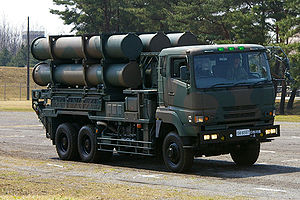|
Type 88 surface-to-ship missile
The Type 88 surface-to-ship missile (88式地対艦誘導弾, SSM-1) is a truck-mounted anti-ship missile developed by Japan's Mitsubishi Heavy Industries in the late 1980s. It is a land-based version of the air-launched Type 80 (ASM-1) missile; in turn it was developed into the ship-launched Type 90 (SSM-1B) missile. The Japan Ground Self-Defense Force bought 54[1] transporter erector launchers, each carrying six Type 88 missiles, for use as coastal batteries. With a range of 180 km (97 nmi; 112 mi), high subsonic speed and 225 kg (496 lb) warhead, it is similar to the US Harpoon missile. In 2015, an upgrade of the Type 88 became operational called the Type 12. The Type 12 features INS with mid-course GPS guidance and better precision due to enhanced TERCOM and target discrimination capabilities. The weapon is networked, where initial and mid-course targeting can be provided by other platforms, and also boasts shorter reload times, reduced lifecycle costs, and a range of 200 km (110 nmi; 120 mi).[2][3] Overview The basic configuration composes the same launcher vehicles and loader vehicles (6 SSM-1), some radar vehicles, fire control systems, and a command control system.[citation needed] Usually, the SSM-1 is launched from within 100 km (62 mi) of the target.[citation needed] See also
References
Wikimedia Commons has media related to Type88 (SSM).
|
||||||||||||||||||||||||||||||||||||||||||

